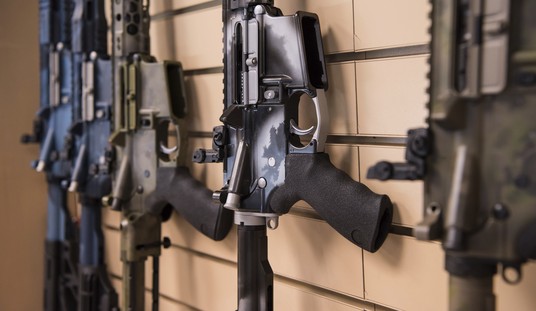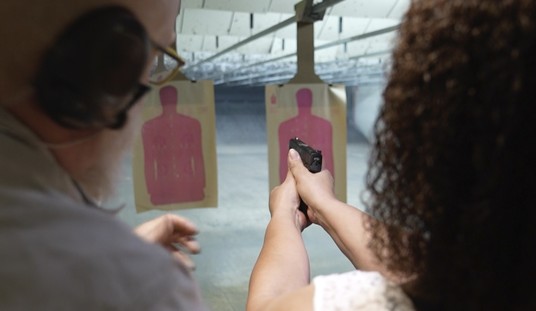 Revolvers haven’t changed much in the last hundred years, but the new Rhino from Chiappa
Revolvers haven’t changed much in the last hundred years, but the new Rhino from Chiappa
Arms is a revolution in the way revolvers look and handle.
The first thing that most people notice about the Italian-made Rhino is that it’s flat. Chiappa took the normal revolver cylinder and shaved off the material between chambers, making a six-sided, six-shot cylinder. Then they notice that the barrel isn’t where it’s supposed to be. On most revolvers the barrel is on top of the gun, but on the Rhino it’s on top of the trigger guard! The goal of the design is to reduce the muzzle rise that affects follow-up shots, especially in the .357 Magnum caliber for which this gun is chambered. This means that the Rhino fires from the bottom chamber of the cylinder, unlike conventional revolvers that fire from the top.
Opening the box
Chiappa ships the gun with a leather belt holster, also made in Italy. Though a rudimentary design (the holster collapses immediately when the gun is drawn), it’s well made and finished. The collapsing mouth makes it extremely difficult to holster without getting the fingers of one’s hand in the way of the muzzle. Anyone who’s serious about safety or understands the need for clean one-handed holstering will want a purpose-designed holster for the gun.
The Rhino’s unusual shape won’t fit any holster made, but Erik Little of Rafter-L Gunleather, one of the country’s best custom holster makers, tells me that as soon as molding dummies are available he’ll offer holsters for the Rhino.
Construction and features
On the left side of the gun is the cylinder release, which is pressed downward to open the cylinder. The lever is just slightly difficult to use, being a bit too close to the edge of the grips. The cylinder opens conventionally to the left. Speedloaders for the Smith & Wesson K-frame revolvers worked fine in the Rhino’s cylinder.
The sights are fixed, and the Rhino’s design results in the sights being significantly (about 1-1/2 inches) above the bore line of the barrel. Those familiar with the AR-15 rifle will recognize the need to compensate for sight offset at close distances. The rear sight is unusual in that it is a slot milled into the hammer spur. That isn’t a problem, because the Rhino’s hammer doesn’t move when you pull the trigger!
The external hammer is just a cocking device, the real hammer being buried deep inside the frame. The hammer spur is pulled back to cock the gun, but once done springs back to its rest position. Since it doesn’t move when cocked or during shooting, it is always in position to serve as the rear sight.
The standard grip is made from a soft textured rubber. It is very tacky, and significantly reduces the tendency of the gun to slip in the hand.
The grip angle is quite different from most revolvers and is noticeably steeper than average. The frame of the gun is made of aluminum or a similar alloy which accounts for the gun’s light weight of 1lb 14 oz. A 5-shot Ruger SP101 weighs exactly what the Rhino does, but is smaller and carries one less round.
Factory options
Chiappa Arms tells me they’ll have a range of options for the Rhino. Grips will be available in small, medium and large, and there is a double action only kit that replaces the external hammer with a streamlined spurless replacement. This part eliminates the rear sight notch and requires sighting to be done using the wide milled trough in the top strap.
There is one accessory of which CCM readers are getting an exclusive preview! Chiappa offers performance packages for the Rhino which allow the action to be tailored to the shooter’s needs. Called “stage kits”, they’re available in Stages One through Three.
Stage One is for concealed carry and reduces the trigger weight while maintaining reliability. Stage Two reduces the pull weight further, and Stage Three will give the lightest pull but is only designated for competition use.
Given the very complicated lockwork of the Rhino, the kits will be available only from Chiappa-certified gunsmiths. Since I’m a gunsmith, Chiappa sent me one of only a few Stage One kits currently in this country. I installed it in the gun and did the majority of testing with it in place.
The Stage One kit took the Rhino’s trigger from 11.5 lbs. (double action) and 5 lbs. (single action) down to 10.25 lbs. and 3.75 lbs., respectively.
Testing the Rhino
I carried the Rhino on a daily basis for about three weeks, using their holster on my right hip, and shot it frequently. (I also carried my own backup gun in case the Rhino failed to function for any reason.)
Local firearms instructor Jim Jacobe and his staff shot the gun and gave me their impressions, along with top trainer Georges Rahbani and his brother Maurice. I also had Rob Pincus, founder of I.C.E. Training and a USCCA Advisory Board member, shoot it and give me his thoughts.
Carryability and ergonomics
The Rhino’s flat shape and light weight makes it very comfortable to wear using the supplied high-ride holster, but other issues blunted the gun’s appeal.
The trigger reach was much too long for my relatively small hands. I couldn’t get more than the tip of my finger on the trigger, which gave me precious little leverage against the action’s weight. On most revolvers I can simply rotate the gun slightly into my grip so that I can reach the trigger, but the Rhino’s unusual grip angle made that an unworkable solution. Feedback from the other testers confirmed my opinion that the Rhino is suitable only for those with medium to long fingers.
The Rhino trigger has a very short travel, but displays a big increase in pull weight in the middle of that travel with a big decrease toward the end of its travel. The best description is that it feels like you’re going over a “hump” in the middle of the pull and it makes shooting the Rhino substantially more difficult than the weight would lead one to believe. It was not possible to use double action without the sights jumping significantly off target. This characteristic was present both with and without the Stage One kit installed.
This hump also makes cocking to single action difficult. It was not a one-hand procedure for any of the two dozen people who ended up handling the gun. Once you get past the effort of cocking, single action is smooth and acceptably light.
How it shoots
The extremely low bore axis does in fact result in less perceived recoil! Standard pressure .38 Special ammunition felt like shooting a .22 Magnum, while heavy .357 Magnum loads felt like .38 Special +P ammo. It was actually a pleasure to shoot magnums in the Rhino. The reduced muzzle flip makes fast follow-up shots absurdly easy. The gun doesn’t jump off target as far, which means the sights come back on target much sooner.
What the others thought
Almost everyone complained about the double action trigger, saying things like “way too heavy” and “hurts my finger to pull” even with the reduced pull weight of the Stage One kit. Two people with meaty fingers reported that the knuckle of their middle finger was hit in recoil by the back of the trigger guard. Neither would shoot more than a few rounds, finding it too painful to continue. Several noted that they didn’t like the cylinder release.
The increased speed at which the gun could be accurately shot was much appreciated, as was the Rhino’s accuracy. Everyone liked the reduction in muzzle flip and perceived recoil, calling it the gun’s best attribute.
The good, the bad, and the ugly
PROS: The accuracy is great, but the biggest plus for the Rhino is definitely the recoil characteristics. It is, without a doubt and by a good margin, the softest-shooting medium framed .357 Magnum revolver on the market. The flat shape makes it easy to carry.
CONS: The double action trigger stroke is a huge issue, even with the lighter Stage One kit installed. The trigger requires much more effort than weight measurements would suggest, and the hump in the pull degrades achievable accuracy. The long trigger reach is a concern for small hands, while thicker hands may have clearance issues. Different grips may alleviate both issues, but as tested the Rhino is only suitable for those with medium to large sized hands of average shape. If your fingers are short or thick, you’re going to have problems with the Rhino.
Initially I was very excited about the Rhino. There’s a lot to like about the gun, but there are also serious usability issues that make it less than pleasant to live with. I’ll revisit the Rhino once smaller grips come to the market and some attention is paid to the quality of the trigger pull.








Join the conversation as a VIP Member